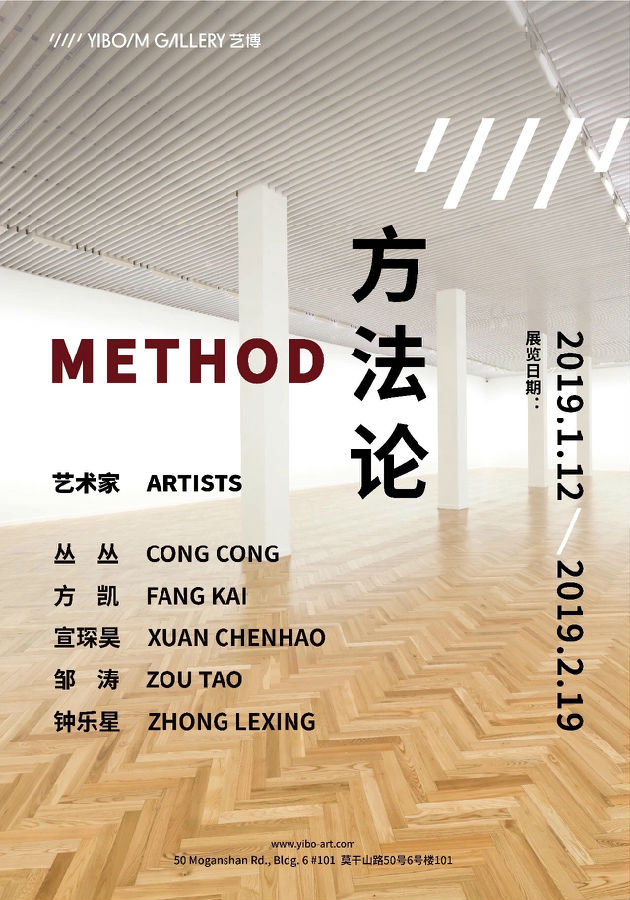
艺博画廊欣然呈献「方法论」展览,展出丛丛(CongCong)、方凯(FangKai)、宣琛昊(Xuan Chenhao)、邹涛(zoutao)、及钟乐星(zhong lexing)的精彩作品。展览「方法论」由艺术家钟乐星参与组织策划,旨在讨论艺术家个体工作方法及看待世界的眼光。
这几天读《知音》,书上讲有个公式来比喻中、日、韩这三个国家的饮食。
A+B=C
A+b=A’
A+B=A’B’
这里写的 A 表示原材料,B 表示加工方法。
第一个公式是中国,中国饮食使用各样的材料和调味品,制作出完全不同于原材料的新的东西,经常出乎人们的意料之外。
第二个公式是日本,日本不提倡过分加工,因此用小写的 b。一种原材料在经过加工之后,没有产生出新的东西,而是更强化和凸现了原材料的特征。
第三个公式是韩国,原材料和调味品处于一种相互渗透的混合状态,即没有产生新东西,也没有强化什么特征。
以我的浅见书上讲的是,说3个公式还可以来表示各国文化特征与差异。但我转念想作为个体的艺术家也该是一样,每个艺术家都要有自己的艺术观和呈现此艺术观、效应、概念可供选择大写的“B”。我极少相信艺术家有“灵感”这回事情,这东西大约等于“灵光”,我以为不足长信。极端一些讲每个艺术家都是发明家,他们要去创造新的东西,告诉我们另外一种看世界的眼光。如此便要求艺术家都要有属于各自的“加工方法”。这帮人对周遭总有新的好的意思,然而这意思如何准确的告诉与被感知?。通常艺术作品是由媒介,信息 2部分构成。媒介是能看见的物属性,艺术作品所传递的信息多又因人而异。假若你感觉“愉悦”,艺术家是通过怎样的方法而达其目的。从媒介到信息是两座大山,艺术家的方法是它们之间的路。
五迷三道的当代艺术,其核心价值是艺术家的思考。这些思考怎样有效的表达与被言说,这是我把伙伴们邀请上台来的目的。此样想法对与不对,我到现在没有把握。我有把握的仅是:中国菜比日本菜、韩国菜要好吃。
—-钟乐星

Yibo Gallery is pleased to present “Method” exhibition, featuring works by CongCong, FangKai, Xuan Chenhao, Zoutao, and Zhong Lexing. The exhibition "Method" is organized by artist Zhong Lexing to discuss the artist's individual working methods and visions of the world.
Recently I have been reading Zhi Yin Magazine. There are some formulas in the book, to compare the cuisines of three countries: China, Japan and Korea.
A+B=C
A+b=A’
A+B=A’B’
The A here indicates the raw material, and B represents for the processing method.
The first formula is China. Chinese cuisine uses various materials and condiments to create new dishes, which are completely different from the raw materials, usually in an unexpected way.
The second formula represents Japan, which does not advocate excessive processing. Thus the letter stands for processing method, “b”, is lowercased. After being processed, the raw materials are not turned into a completely new form. Instead, their raw characteristics and essences are strengthened and highlighted.
The third formula is South Korea. Raw materials and condiments are in a state of mutual infiltration. Hence the materials are presented in a simply mixed state, not re-created into new form or strengthened.
In my humble opinion, the book is right about the three formulas. They can be also applied to represent the characteristics and differences of the cultures of the countries. Furthermore, the same mindset can also be referred to individual artists. Each artist shall have his/her own artistic conception, personal art language, and effects; which could be concluded and represented as a capitalized "B" in the formula above. I rarely believe that artists have or rely on “inspiration” – which to my belief roughly equal to "aura", and not sufficient enough. Every artist is an inventor to some extent. They aim to create something new and share with the viewers another way of looking at the world. This requires artists to have their own "processing methodology". The artists observe the surroundings and the world with kindness, imagination and inquisitive minds. At the same time, how could their observation be precisely perceived and interpreted through their artworks? Generally an artwork consists of two parts: medium and information. The medium is the attribute of object that everyone can recognize visually. The information and emotions conveyed by the artwork vary from person to person. When the viewer feels "happy" looking at the artwork, the methodology of the artist is applied to reach the certain effect. In my view, the methodology of the artist is the bridge connecting the medium and the information.
The core value of the puzzling and complex contemporary art, is the thinking and methodology of artists. The purpose that I curate this exhibition with my fellows is to explore how to effectively express and interpret the thoughts and explorations of the artists. I am not sure whether my idea is right, but only certain that Chinese food is better than Japanese and Korean food.
——Zhong Lexing